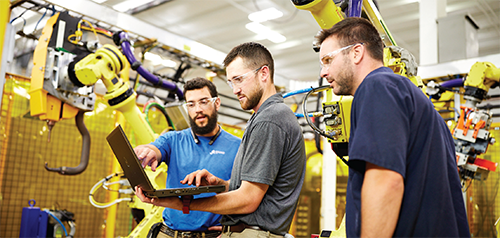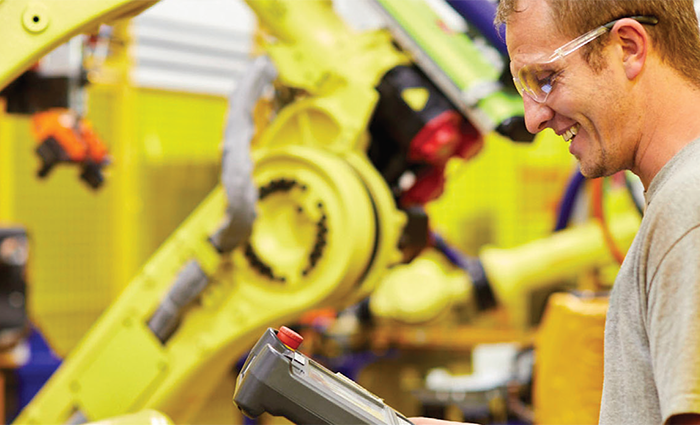How JR Automation positions itself as the partner for success
Seamless solutions
Founded in 1980, JR Automation has evolved over the years to provide intelligent automated manufacturing and distribution technology solutions that transform the way the world’s leading manufacturers make and distribute products.
As a consequence of strategic acquisitions and organic growth, the business boasts more than 1,700,000 square feet of automation and engineering space around the world. Acquired by Hitachi, Ltd. in 2019, JR Automation is now able to accomplish even more for its customers by combining its expertise in robotic system integration with Hitachi’s deep skill sets in artificial intelligence and IoT technologies for manufacturing.
Uniting its five divisional brands in 2021, JR Automation is able to offer more innovative solutions and areas of expertise than any other company, providing customers with seamless services and connecting the entire value chain with data to achieve total optimization.
 “We are a large automation integrator with a wide variety of expertise,” explains Craig Ulrich, CEO. “With specialty divisions in different geographic regions, we are able to feel more relevant, local and personal to our customers while simultaneously, being able to leverage the breadth of expertise afforded by our scale. This local feel, combined with our geographical reach and extensive knowledge base help to set us apart from the competition.”
“We are a large automation integrator with a wide variety of expertise,” explains Craig Ulrich, CEO. “With specialty divisions in different geographic regions, we are able to feel more relevant, local and personal to our customers while simultaneously, being able to leverage the breadth of expertise afforded by our scale. This local feel, combined with our geographical reach and extensive knowledge base help to set us apart from the competition.”
Manufacturing plants tend to have separate Operational Technology (OT) and Information Technology (IT) divisions. The former denotes systems that monitor and govern physical equipment, whereas the latter encompasses digital information and infrastructure. As Craig suggests: “It’s very rare that a company can provide both capabilities to their customer base. Again, I think our size and ability to adapt allows us to do that. In fact, we try to no longer differentiate between the two. Our approach bridges the divide to create a fully integrated smart solution.”
In essence, JR Automation is reacting to the fourth revolution that is occurring in manufacturing. Industry 4.0 represents the adoption of smart and autonomous systems that are fuelled by data and machine-learning. INGENOVA360™ is JR Automation’s suite of software that fully connects equipment to an intelligent planning and control system, delivering the information needed to make strategic decisions on every business level.
“We integrate our equipment into our customers’ Enterprise Resource Planning (ERP) systems to enable automatic scheduling. While many companies are capable of building the automation equipment, we are able to both provide and seamlessly integrate it as a one-stop service offering,” Craig enthuses.
Senior Vice President of Sales & Marketing, Thomas Rozema, agrees: “I think it’s an unmet need in the industry and we are uniquely positioned with the support of the powerhouse that is Hitachi to deliver not only the automation but the additional value of the digital solution too.”
In essence, JR Automation is reacting to the fourth revolution that is occurring in manufacturing. Industry 4.0 represents the adoption of smart and autonomous systems that are fuelled by data and machine-learning. INGENOVA360™ is JR Automation’s suite of software that fully connects equipment to an intelligent planning and control system, delivering the information needed to make strategic decisions on every business level.
“We integrate our equipment into our customers’ Enterprise Resource Planning (ERP) systems to enable automatic scheduling. While many companies are capable of building the automation equipment, we are able to both provide and seamlessly integrate it as a one-stop service offering,” Craig enthuses.
Senior Vice President of Sales & Marketing, Thomas Rozema, agrees: “I think it’s an unmet need in the industry and we are uniquely positioned with the support of the powerhouse that is Hitachi to deliver not only the automation but the additional value of the digital solution too.”
Holistic solutions
Vice President of Digital Solutions, Mike Lashbrook, adds: “I would say a further consideration is the human factor, and understanding that now we have all this data at our fingertips, it’s crucial to make sure we are using it properly, and sharing it at the right level. Ultimately, decisions need to be made on the manufacturing floor. To enable team leaders to make the correct decisions and implement continuous improvement activities, information needs to be accessible to the right people. It’s not simply a case of providing management with graphs and charts. Empowering the workforce to make decisions based on available data is intrinsic for growth. It takes an organizational level of training and leadership to ensure automation solutions are exploited to their full potential.
“When data and equipment is implemented, it’s crucial to know how to use it in a way to actually improve business. We like to understand what problem our clients are trying to solve. From productivity improvement to quality enhancement, understanding a client’s motivation provides better transparency when it comes to how the operator works with the equipment. This enables us to use the data to better resolve the issue in a collaborative manner.”
 Indeed, it would seem the business is uniquely positioned to develop partial-automation as a key area of opportunity. For example, as Mike elaborates: “The general assembly lines we supply for automotive makers haven’t changed dramatically in decades, and are not likely to. We have tried to automate more and more, but we will never remove the people aspect from the general assembly process of an automotive plant, and there are many other manufacturing processes that are similar. The more we can incorporate that element into the bigger picture, the better we’re able to offer more holistic solutions.”
Indeed, it would seem the business is uniquely positioned to develop partial-automation as a key area of opportunity. For example, as Mike elaborates: “The general assembly lines we supply for automotive makers haven’t changed dramatically in decades, and are not likely to. We have tried to automate more and more, but we will never remove the people aspect from the general assembly process of an automotive plant, and there are many other manufacturing processes that are similar. The more we can incorporate that element into the bigger picture, the better we’re able to offer more holistic solutions.”
By understanding and responding to key operational drivers, JR Automation seeks to not only deliver its core offering of robotic automation, but moving forward, to also make sure it integrates software and systems as a seamless solution, for every client, from day one.
As Mike explains: “This approach really requires a greater understanding of our clients. Instead of being just an automation solution provider, we need to co-develop partnerships with our customers to understand the root of what they are asking us to solve. We can then uncover the necessary data, and integrate solutions from day one that can be maintained and supported for years to come. A life-cycle management approach drives continuous improvement. While we don’t want breakdowns to occur, if we can better predict when they’re likely to, we can help our clients to better manage occurrences, alleviate the effects, and mitigate against them with preventative maintenance.”
Looking to the future, the team at JR Automation places considerable emphasis on company culture and how that filters through to customer service. Craig highlights: “We need to make sure we are functioning well locally and that we are a cohesive team in the regions in which we work. Through our visions and values, we act as a global organization but with a local focus. We do that by various means. For example, each area has a community care fund through which charitable giving is fed back to the good of the local community. This helps to embed the organization in the local community which is good not only for our people, but for our customers too.
“Our people are key to everything we do. We take care of them and in turn, they take care of our customers. From a customer perspective, that is why a local feel is important to us. We don’t want to present ourselves as a faceless conglomerate. Our customers need to feel reassured that the person they worked with on a previous job is going to be the same one they work with on the next job, and the next. They can count on us to produce what they need to run their business in a timely manner. This relationship encourages repeat custom, and in effect, we become an extension of their business. Our success is as a result of our customers’ success.”
Tom reiterates: “While buying habits have traditionally veered towards low cost, I think we are seeing a trend in the industry where customers are really valuing the strategic partnerships we offer. We have about a dozen very large customers that bring repeat revenue on a yearly basis. It’s extremely beneficial; we talk the same language when designing automation, enabling our teams to execute systems with enhanced efficiency and particularly so, from a life cycle management perspective. Not only are we providing new solutions, we’re servicing and supporting those solutions for the long haul.”
Today JR Automation is roughly an 800-million-dollar business. With 28 manufacturing facilities and over 2000 dedicated teammates across the globe, the business continues to grow and evolve to help its customers succeed. As Craig shares: “Our total seamless solutions stand us in good stead for sustained success moving forward.”
www.jrautomation.com
